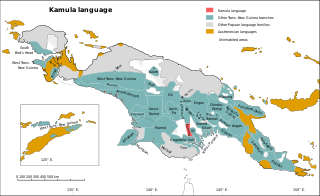Related Research Articles
Kuman is a language of Chimbu Province, Papua New Guinea. In 1994, it was estimated that 80,000 people spoke Kuman, 10,000 of them monolinguals; in the 2000 census, 115,000 were reported, with few monolinguals. Ethnologue also reported 70,000 second language speakers in 2021.
The Senagi languages are a small family of Papuan languages in the classification of Malcolm Ross, that had been part of Stephen Wurm's Trans–New Guinea proposal. They consist of the two languages Angor and Dera.
The Yuat languages are an independent family of five Papuan languages spoken along the Yuat River in East Sepik Province, Papua New Guinea. They are an independent family in the classification of Malcolm Ross, but are included in Stephen Wurm's Sepik–Ramu proposal. However, Foley and Ross could find no lexical or morphological evidence that they are related to the Sepik or Ramu languages.
The Yalë language, also known as Yadë, Nagatman, or Nagatiman, is spoken in northwestern Papua New Guinea. It may be related to the Kwomtari languages, but Palmer (2018) classifies it as a language isolate.
Elseng is a poorly documented Papuan language spoken by about 300 people in the Indonesian province of Papua. It is also known as Morwap, which means "what is it?" ‘Morwap’ is vigorously rejected as a language name by speakers and government officials.

Papua New Guinea, a sovereign state in Oceania, is the most linguistically diverse country in the world. According to Ethnologue, there are 840 living languages spoken in the country. In 2006, Papua New Guinea Prime Minister Sir Michael Somare stated that "Papua New Guinea has 832 living languages ."

The Angan or Kratke Range languages are a family of the Trans–New Guinea languages in the classification of Malcolm Ross. The Angan languages are clearly valid as a family. They were first identified as such by J. Lloyd and A. Healey in 1968; Wurm (1975) classified them as Trans–New Guinea. Glottolog treats Angan as a separate or unclassified family, ignoring further evidence.
The Kwalean or Humene–Uare languages are a small family of Trans–New Guinea languages spoken in the "Bird's Tail" of New Guinea. They are classified within the Southeast Papuan branch of Trans–New Guinea.
Pyu is a language isolate spoken in Papua New Guinea. As of 2000, the language had about 100 speakers. It is spoken in Biake No. 2 village of Biake ward, Green River Rural LLG in Sandaun Province.
Pomio District is a district of East New Britain Province in Papua New Guinea. It is one of the four administrative districts that make up the province.
Kaki Ae, or Tate, is a language with about 500 speakers, half the ethnic population, near Kerema, in Papua New Guinea. It was previously known by the foreign designation Raeta Tati.
Kapori (Kapauri) is a Papuan language of Pagai village in Airu District, Jayapura Regency, Papua, Indonesia.

Kamula is a Trans–New Guinea language that is unclassified within that family in the classification of Malcolm Ross (2005). Noting insufficient evidence, Pawley and Hammarström (2018) leave it as unclassified.

Tabo, also known as Waia (Waya), is a Papuan language of Western Province, Papua New Guinea, just north of the Fly River delta. The language has also been known as Hiwi and Hibaradai.
Namia is a Sepik language spoken in Namea Rural LLG, Sandaun Province, Papua New Guinea. It goes by various names, such as Edawapi, Lujere, Yellow River. Language use is "vigorous" (Ethnologue).
Tapei is an Arafundi language of Papua New Guinea. It is close to Nanubae; the name Alfendio was once used for both.
Yakamul, also known as Kap or Ali, is an Austronesian language spoken in East Aitape Rural LLG, Sandaun Province, Papua New Guinea. It is spoken in the village of Yakamul on the north coast and on the islands of Ali, Angel, and Seleo islands.
Tumleo is an Austronesian language of coastal Sandaun Province, Papua New Guinea, on Tumleo Island and the Aitape coast in East Aitape Rural LLG.
Ali Island is a populated island in East Aitape Rural LLG, Sandaun Province, Papua New Guinea.
Seleo Island is a populated island in East Aitape Rural LLG, Sandaun Province, Papua New Guinea.
References
- ↑ Kol at Ethnologue (18th ed., 2015) (subscription required)
- ↑ Eberhard, David M.; Simons, Gary F.; Fennig, Charles D., eds. (2019). "Papua New Guinea languages". Ethnologue: Languages of the World (22nd ed.). Dallas: SIL International.
- ↑ Dunn, Michael; Reesnik, Ger; Terrill, Angela (2002). "The East Papuan Languages: A Preliminary Typological Appraisal" (PDF). Oceanic Linguistics. 41 (1): 28–62. doi:10.1353/ol.2002.0019. hdl: 11858/00-001M-0000-0013-1ADC-1 . S2CID 143012930 . Retrieved 6 February 2021.
- 1 2 Lindrud, Stellan (October 1992). Kol Language [KOL] East New Britain Province (PDF). Organised Phonology Data: SIL.
- ↑ Greenhill, Simon (2016). "TransNewGuinea.org - database of the languages of New Guinea" . Retrieved 2020-11-05.